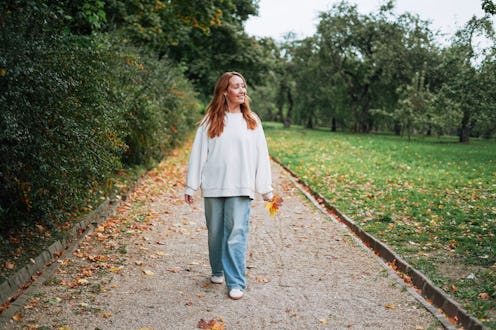
What is it about a walk that’s so refreshing? It always feels like the perfect thing to do when you’re worried, stressed, overwhelmed, or trying to weigh a big decision. The moment you pop in your headphones and step outside, it’s like your anxiety dials down three notches.
It makes sense why movement and fresh air would help you feel better, but a viral TikTok posted by @mindbrainbodylab called out another benefit of walking called “optical flow” and how it could be a major reason why strolling feels so right.
As you strut down the street, your eyes naturally move side to side. You look to the left to check out a pretty tree, then to the right when you see a cute dog, and back to the left to read the sign on a coffee shop. “These lateral movements actually quiet and dampen the emotional fear centers in our brain,” user @mindbrainbodylab said in the clip.
In the comments on the video, someone wrote, “You just explained a lot about my life. All I want to do is walk. It’s the thing that makes me the happiest. Wow. Wow.” Another said, “I have anxiety and walking has really helped me feel relaxed.”
Optical flow could be the real reason a walk is your go-to strategy for coping with stress. Below is all the information as to why this may be.
Why Walking Is So Relaxing
According to Ciara Bogdanovic, LMFT, a licensed psychotherapist and founder of Sagebrush Psychotherapy, optical flow is what happens when your eyes scan your environment while you walk — and it’s a true recipe for calm.
“It is our brain processing where we are in space,” she tells Bustle. Stepping outside opens up your visual field, allowing you to look around and take in your surroundings. Unlike the narrow, hyper-focused attention that you might have when you’re cooped up inside or staring at a screen, a walk opens your peripheral vision and signals to your brain that you’re safe.
Walking also engages bilateral stimulation, she says, which is any rhythmic left–right stimulation of the body. As you look to the left, then the right, you ping the logic and emotional centers of the brain simultaneously, which can help you process your feelings.
“Bilateral stimulation activates both hemispheres of the brain in a coordinated rhythm, which leads to reprocessing of emotions and memories and integrates information into our brain in a new way,” Bogdanovic says. “It creates the conditions for your brain to link emotions with understanding, to soften their intensity, and to move them into long-term, integrated memory.”
This type of bilateral stimulation is actually the basis for EMDR therapy, which simulates similar eye movements as a way to process trauma and release emotions. “[This form of stimulation] was discovered by Dr. Francine Shapiro, the founder of EMDR therapy, while on a walk,” Bogdanovic says. Shapiro noticed that strolling helped her process emotions, and later applied it to her therapy practice.
How To Make The Most Of Your Walk
The best thing about optical flow is that you don’t have to force it. Simply go outside and enjoy your stroll like you always do. “A walk provides that space through rhythm, gentle bilateral stimulation, and the simple act of being outside so your nervous system can shift without you forcing it,” Bogdanovic says.
That said, there are ways to make sure your time outside even more relaxing. She recommends finding a place that brings you peace, whether that means taking a spin around your favorite neighborhood or trekking to your favorite corner of the park.
As you go, allow your mind — and your eyes — to wander. “Don't get stuck on any one thought,” she says. “Allow each thought to come and go.” This approach should help your body calm down, while also allowing you to relax enough to look around.
Another tip? Engage your senses. Take note of what you see, hear, and feel. If you need an objective, go on a color walk and keep an eye out for a certain hue as you stroll. While it is OK to listen to music or a podcast, Bogdanovic reminds you not to look down at your phone too often. To make the most of your walk, allow yourself to fully be in the moment, taking in your surroundings.
Source:
Ciara Bogdanovic, LMFT, licensed psychotherapist, founder at Sagebrush Psychotherapy